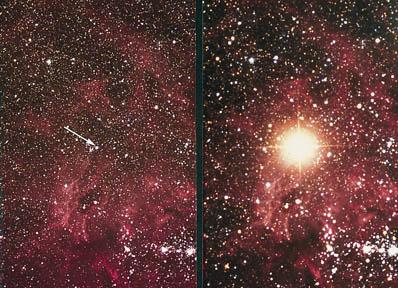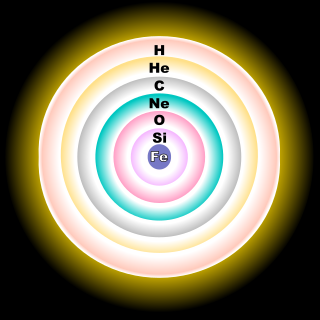Page 2 of 2
Re: APOD: Doomed Star Eta Carinae (2012 Dec 30)
Posted: Sun Dec 30, 2012 8:55 pm
by BDanielMayfield
orin stepanek wrote:IMHO; since Eta Carinae spewed out those two lobes; I would think that would extend it's life some! My reasoning is that a lot of pressure would have been alleviated within it's core!

I think what you suggest is at least to some extent a mathematical certainly Orin, since the fusion rates in the cores and in the case of very massive stars the shells surrounding the cores are functions dependent in part on both temperature and pressure, and both must decrease somewhat as intense stellar winds carry away much mass.
Tszabeau wrote:After reading the linked info., I am fuzzy on why Eta Carinae is considered a "rogue star". I thought a rogue was on it's own and not part of a larger system such as galaxy. For example, a rogue planet would not be part of a solar system. I assume that my assumptions must be wrong so what makes it rogue?
You’re right that calling Eta Carinae a “rogue star” is now a bit confusing Tszabeau. I think they may have meant rogue in the sense of beast or maybe monster, in view of its huge mass and explosive disposition and destiny. I like your comparison to rogue planets, and I think it would be sensible to use the expression only for stars that have been thrown or pulled lose from a galaxy.
Bruce
Re: APOD: Doomed Star Eta Carinae (2012 Dec 30)
Posted: Sun Dec 30, 2012 9:05 pm
by bjmb
Chris Peterson wrote:that's why astronomers rarely make any effort to consider when something "really" happened,
not true, they make enormous efforts to determine the distance of objects, i.e. how long ago any phenomenon observed 'really' happened
***
Chris Peterson wrote:as all that matters is when the observation occurs.
***
exactly, 'when the observation occurs' - so what's so repugnant about saying 'in 1835 eta carina was noticed/observed to shine brighter'? whether that is 'all that matters' is not for the observer to decide - for me hygiene in language matters as well
Re: APOD: Doomed Star Eta Carinae (2012 Dec 30)
Posted: Sun Dec 30, 2012 10:19 pm
by Doum
It look like a terrible monstrous wild destructive star. And yet, it's magnificent and impressive.

Re: APOD: Doomed Star Eta Carinae (2012 Dec 30)
Posted: Mon Dec 31, 2012 6:28 am
by Ann
BDanielMayfield wrote:orin stepanek wrote:IMHO; since Eta Carinae spewed out those two lobes; I would think that would extend it's life some! My reasoning is that a lot of pressure would have been alleviated within it's core!

I think what you suggest is at least to some extent a mathematical certainly Orin, since the fusion rates in the cores and in the case of very massive stars the shells surrounding the cores are functions dependent in part on both temperature and pressure, and both must decrease somewhat as intense stellar winds carry away much mass.
You could be right, but I'm not sure. Remember that it's the state of the core that decides whether or not there will be a supernova explosion. I once read that the outer layers of an evolved star "have no idea" what the core is doing, so a supernova explosion always comes as an utter surprise to the poor outer layers of the star!

Similarly, I'm not too sure that an evolved core "knows" what the outer layers of the stars are doing. Blowing off parts of the outer layers of the star will not change the state of the core. Professor emeritus Jim Kaler, an experts on stars, wrote this about a Wolf-Rayet star (an enormously mass-losing former supergiant star with an evolved core:
The windy WR star probably started with somewhere around 40 solar masses and has now stripped itself down by an unknown amount, perhaps to under 10. Only a few million years old, the visually fainter Wolf-Rayet component is almost certainly in the last stages of preparing to blow up as a supernova.
So even though this star may have blown off so much of its outer layers that it may have lost three quarters of its mass, it is still believed to be doomed to go supernova!
BDanielMayfield wrote:Tszabeau wrote:After reading the linked info., I am fuzzy on why Eta Carinae is considered a "rogue star". I thought a rogue was on it's own and not part of a larger system such as galaxy. For example, a rogue planet would not be part of a solar system. I assume that my assumptions must be wrong so what makes it rogue?
You’re right that calling Eta Carinae a “rogue star” is now a bit confusing Tszabeau. I think they may have meant rogue in the sense of beast or maybe monster, in view of its huge mass and explosive disposition and destiny. I like your comparison to rogue planets, and I think it would be sensible to use the expression only for stars that have been thrown or pulled lose from a galaxy.
I agree that using the term "rogue star" for Eta Carinae is rather confusing.
Ann
Re: APOD: Doomed Star Eta Carinae (2012 Dec 30)
Posted: Tue Jan 01, 2013 10:05 pm
by BDanielMayfield
I wrote what I did in response to Orin because of what I’ve learned about stellar interiors in my reading about astrophysicists. While the cores of stars and their surfaces don’t “know” about each other, they do “feel” the effects of each other. The pressure felt at the core is caused by the weight of all the overlaying material pressing in upon it. Temperature and pressure inside stars are directly proportional to each other. The photosphere “feels” the effect of the core’s energy as heat flows from the core to the cooler exterior. So much heat reaches the surface that some of the outermost material flows away in the stellar wind. In large stars not enough material is lost to stave off the eventual SN explosion, but this effect (stellar wind) must prolong the lifetime of most stars as core pressure and therefore tempurature is at least somewhat reduced.
Re: APOD: Doomed Star Eta Carinae (2012 Dec 30)
Posted: Wed Jan 02, 2013 5:26 am
by Ann
Bruce, I definitely see your point. You may certainly be right. In the case of Eta Carinae, perhaps that large outburst that the star had in 1843 extended the life of that star so that it is still with us (or at least, so that we can still see it in our skies).

Sanduleak -69° 202 and SN 1987A.
Photo: David Malin.
Since I've taken a great amateur interest in blue stars, I have come to respect how truly individual they are. One blue star may behave in a way that is not normal for another. I still find it interesting that Sanduleak -69° 202, the progenitor of Supernova 1987A in the Large Magellanic Cloud, looked so unremarkable. It was a blue supergiant which looked quite modest, and which may well have lost quite a lot of mass before it exploded. There are many stars in the LMC that look so much more impressive. Why was Sanduleak -69° 202 the one that blew?
On the other hand, what about the progenitor of SN 2009ip? It had such a great outburst in 2009 that it was classified as a supernova that year.
Yet the star survived, only to blow for real in 2012, only three years later. Isn't it remarkable?
Ann

